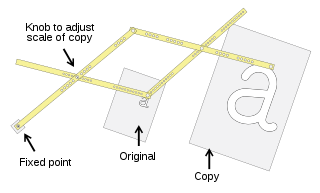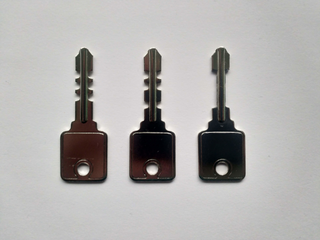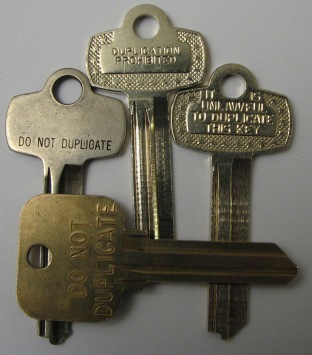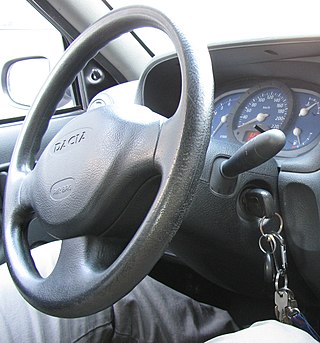
A pantograph is a mechanical linkage connected in a manner based on parallelograms so that the movement of one pen, in tracing an image, produces identical movements in a second pen. If a line drawing is traced by the first point, an identical, enlarged, or miniaturized copy will be drawn by a pen fixed to the other. Using the same principle, different kinds of pantographs are used for other forms of duplication in areas such as sculpting, minting, engraving, and milling.

Lock picking is the practice of unlocking a lock by manipulating the components of the lock device without the original key.

A warded lock is a type of lock that uses a set of obstructions, or wards, to prevent the lock from opening unless the correct key is inserted. The correct key has notches or slots corresponding to the obstructions in the lock, allowing it to rotate freely inside the lock.

In machining, a shaper is a type of machine tool that uses linear relative motion between the workpiece and a single-point cutting tool to machine a linear toolpath. Its cut is analogous to that of a lathe, except that it is (archetypally) linear instead of helical.

A lock is a mechanical or electronic fastening device that is released by a physical object, by supplying secret information, by a combination thereof, or it may only be able to be opened from one side, such as a door chain.

A lever tumbler lock is a type of lock that uses a set of levers to prevent the bolt from moving in the lock. In the simplest form of these, lifting the tumbler above a certain height will allow the bolt to slide past.

Padlocks are portable locks usually with a shackle that may be passed through an opening to prevent use, theft, vandalism or harm.

A Tool and Cutter Grinder is used to sharpen milling cutters and tool bits along with a host of other cutting tools.

A key blank is a key that has not been cut to a specific bitting. The blank has a specific cross-sectional profile to match the keyway in a corresponding lock cylinder. Key blanks can be stamped with a manufacturer name, end-user logo or with a phrase, the most commonly seen being 'Do not duplicate'. Blanks are typically stocked by locksmiths for duplicating keys. The profile of the key bow, or the large, flat end, is often characteristic of an individual manufacturer.

Bitting is the depth of key cuts on a cylinder key for a pin tumbler lock, often expressed as a number. Bitting also refers to the combination of key cuts on a bit key for a warded lock or lever tumbler lock.

A car key or an automobile key is a key used to open and/or start an automobile. Modern key designs are usually symmetrical, and some use grooves on both sides, rather than a cut edge, to actuate the lock. It has multiple uses for the automobile with which it was sold. A car key can open the doors, as well as start the ignition, open the glove compartment and also open the trunk (boot) of the car. Some cars come with an additional key known as a valet key that starts the ignition and opens the driver's side door, but prevents the valet from gaining access to valuables that are located in the trunk or the glove box. Some valet keys, particularly those to high-performance vehicles, go so far as to restrict the engine's power output to prevent joyriding. Recently, features such as coded immobilizers have been implemented in newer vehicles. More sophisticated systems make ignition dependent on electronic devices, rather than the mechanical keyswitch. A number of these systems, such as KeeLoq and Megamos Crypto have been demonstrated to be weak and vulnerable to cryptanalytic attacks.
Medeco, a subsidiary of the Swedish Assa Abloy Group, is a lock manufacturer located in Roanoke County, Virginia, United States.
A key code is a series of alphanumeric characters used by locksmiths to create a key. There are two kinds of key codes: blind codes and bitting codes.

A wafer tumbler lock is a type of lock that uses a set of flat wafers to prevent the lock from opening unless the correct key is inserted. This type of lock is similar to the pin tumbler lock and works on a similar principle. However, unlike the pin tumbler lock, where each pin consists of two or more pieces, each wafer in the lock is a single piece. The wafer tumbler lock is often incorrectly referred to as a disc tumbler lock, which uses an entirely different mechanism.
Schlage is an American lock manufacturer founded in 1920 by Walter Schlage. Schlage was headquartered in San Francisco from its inception until it relocated to Colorado Springs, Colorado, in 1997. Schlage also produces high-security key and cylinder lines Primus, Everest, and Everest Primus XP. Schlage is one of the most popular brands of consumer and commercial locks in the United States.

An interchangeable core or IC is an adaptable locking key cylinder, which can be rapidly exchanged in the field via the use of specialized "control keys".
In mechanical engineering, a key is a machine element used to connect a rotating machine element to a shaft. The key prevents relative rotation between the two parts and may enable torque transmission. For a key to function, the shaft and rotating machine element must have a keyway and a keyseat, which is a slot and pocket in which the key fits. The whole system is called a keyed joint. A keyed joint may allow relative axial movement between the parts.

In master locksmithing, key relevance is the measurable difference between an original key and a copy made of that key, either from a wax impression or directly from the original, and how similar the two keys are in size and shape. It can also refer to the measurable difference between a key and the size required to fit and operate the keyway of its paired lock.
Key control refers to various methods for making sure that certain keys are only used by authorized people. This is especially important for master key systems with many users. A system of key control includes strategies for keeping track of which keys are carried by which people, as well as strategies to prevent people from giving away copies of the keys to unauthorized users. The former may be as simple as assigning someone the job of keeping an up-to-date list on paper. A more complex system may require signatures and/or a monetary deposit.
This is a glossary of locksmithing terms.















